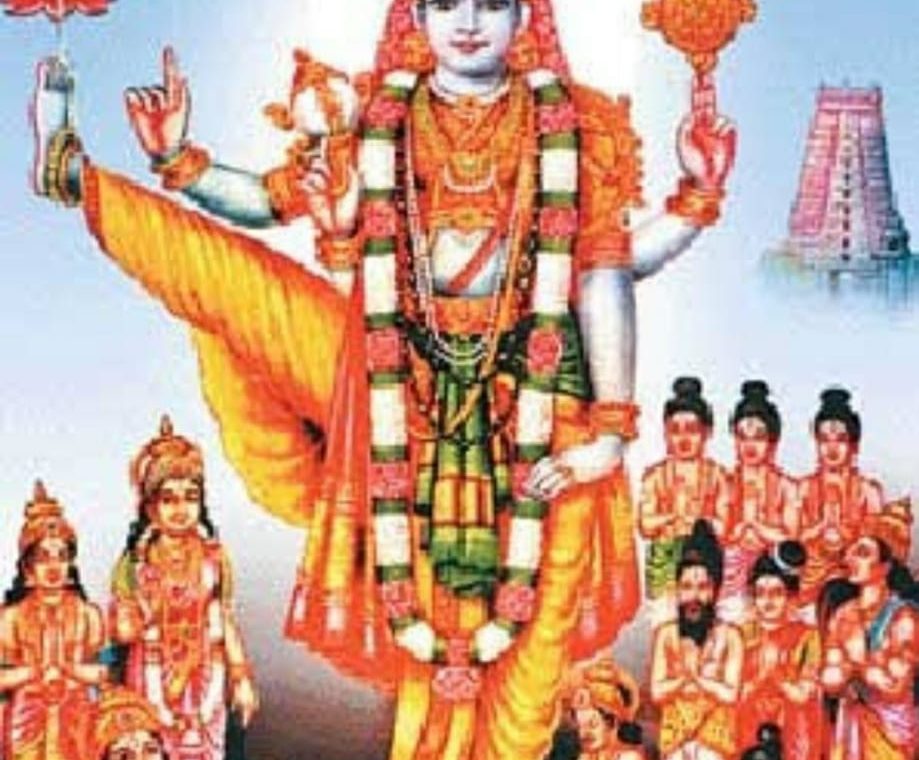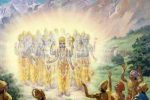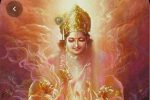NAME 53
Sthaviṣṭhaḥ स्थविष्ठः
Sthaviṣṭha literally means strong or bulky. Sthaviṣṭha is the superlative degree to indicate gross form. Brahman is stronger than the strongest, bulkier than the bulkiest, grosser than grossest. Superlative degrees are used to define His attributes and even then, no one is able to describe Him properly. This is because He is bigger than the biggest and smaller than the smallest.
Kaṭha Upaniṣad (I.ii.20) says, “aṇor aṇīyān mahato mahīyān” which means He is smaller than the smallest and bigger than the biggest. The Brahman has to be this way, as He is omnipresent. Everything is His creation and all that exist are His reflective images.
Sthavishta – One who is exceedingly huge in size. The name is derived from the two words Sthula and Ishtha – One who willed to be huge. The Infinite as the subtlest is All-Pervading in Its own nature. It is this Maha- Vishnu who has Himself become the entire universe of gross things and beings. Just as all waves are the ocean, the total world of gross things is itself the form of Vishnu. In His cosmic form, Narayana had manifested to Arjuna in the Geeta. There the words of Arjuna’s chant will clearly bring home to us that the entire gross world is ever His own Divine form.
विशेषस्तस्य देहोऽयं स्थविष्ठश्च स्थवीयसाम् ।
Śrīmad Bhāgavata – Canto 2, Chapter 1, verse 24
यत्रेदं व्यज्यते विश्वं भूतं भव्यं भवच्च सत् ॥ २४ ॥
viśeṣas tasya deho ’yaṁ
sthaviṣṭhaś ca sthavīyasām
yatredaṁ vyajyate viśvaṁ
bhūtaṁ bhavyaṁ bhavac ca sat
In His extraordinary body which is spread as the grossly material matter of this universe – all of this phenomenon is experienced as the past, future and present.
५३. ॐ स्थविष्ठाय नमः |
53. OM Sthaviṣṭhāya Namaḥ
Sthavishthah -lt is the superlative degree of gross (sthoola) and thus ‘the Supremely gross’ is the subtlest Reality. The contradiction that it contains is itself its vigour and beauty. The Infinite as the subtlest is All-Pervading in Its own nature. It is this Maha- Vishnu who has Himself become the entire universe of gross things and beings. Just as all waves are the ocean, the total world of gross things is itself the form of Vishnu.
In His cosmic form, Narayana had manifested to Arjuna in he Geeta. There the words of Arjuna’s chant will clearly bring home to us that the entire gross world is ever His own Divine form.
INTERPRETATION GUDIED BY SANT VANI (WORDS OF SAINTS)
Sthaviṣṭhaḥ (also name 436)
The stoutest.
The Lord is Sthaviṣṭha, the stoutest because He is the virāt, in the form of the entire cosmos.
When we look at the ocean, we are struck by its vastness. When we look at the sky, during the day, again we are amazed by how expansive it is. Certainly the cosmos seems to be bigger than where the eyes or even the telescope reach. Since the earth, the skies, the mountains, the oceans and so on, are included in Him, there can be nothing stouter than Him.
He who is huge, corpulent, sturdy, gigantic, and the greatest of the great – the ‘Sthūla’. He who is both the grossest of the gross and the subtlest of the subtle – He who decided to ‘expand’ himself and become the “many” – the multitude of forms that we see in the Universe.
He who broke the cosmic egg “Brahmāṇḍa” and initiated the process of Universal expansion then.
Even though this may appear contradictory – how can he who is ‘limitless’ also appear as “limited” at times, how can he who is huge also be tiny. This is explained by using the example of the ocean – Just as the Ocean and its waves are the same, though they appear different and are referred to by different names, they both are the same. The Wave is present in the Ocean even as the Ocean is present in the Wave – such is the source and manifestation of the Supreme Being.
The reference to the limitlessness of the Supreme being and he being both the expanse as well as all the forms that we see finds mention in the Bhagavad-gītā and the reference to him being the breaker of the “Brahmāṇḍa” in the Nārāyaṇīyam.
अनेकबाहूदरवक्त्रनेत्रं
Bhagavad Gita: Chapter 11, Verse 16
पश्यामि त्वां सर्वतोऽनन्तरूपम् |
नान्तं न मध्यं न पुनस्तवादिं
पश्यामि विश्वेश्वर विश्वरूप || 16||
aneka-bāhūdara-vaktra-netraṁ
paśhyāmi tvāṁ sarvato ’nanta-rūpam
nāntaṁ na madhyaṁ na punas tavādiṁ
paśhyāmi viśhveśhvara viśhva-rūpa
Arjuna says: Countless are your eyes, stomach, and forms. I can neither see your beginning, or the middle, nor the end – such is your expanse.
अण्डं तत्खलु पूर्वसृष्टसलिलेऽतिष्ठत् सहस्रं समा:
Narayaneeyam Dashaka 5.10
निर्भिन्दन्नकृथाश्चतुर्दशजगद्रूपं विराडाह्वयम् ।
साहस्रै: करपादमूर्धनिवहैर्निश्शेषजीवात्मको
निर्भातोऽसि मरुत्पुराधिप स मां त्रायस्व सर्वामयात् ॥5-१०॥
This Golden Egg or Brahmanda remained in the preexisting cosmic waters for a thousand years. Thereafter, breaking it You made it into 14 spheres (worlds), which is actually your Viraat Roopa (cosmic form); and within this it is you who shine forth as all the manifested beings seen as thousands of hands, feet, heads, eyes, etc of that Viraata Roopa.
As Sri Ramakrishna Parahamsa used to say:
“Many are the names of God, and infinite the forms that lead us to know Him. In whatsoever name or form you desire to call Him, in that very form and name you will see Him.”
At a practical level, this flows meaningfully from the previous three names in this string: As architects and creators of our own destinies, who ‘chisel’ and create the world as we want it to be, by turning our gaze inwards and focusing on that which is really important, we realize that our vision expands and we truly become inclusive and start to see how each and every being, object, event, and so on is actually the very same reality that lives within us. It can have different names, various forms, sizes, shapes but beneath it all, there is a single thread that connects all of us and that thread that strings all of these ‘beads’ together is the Supreme being – Viṣhṇu or Nārāyaṇa – He “lives” everywhere and lives in all…
https://os.me/thing-ever-need-know/
The Cosmic Egg
Once upon a time there was a tiny golden egg. It had no mother. It had no father. At least it didn’t in the literal sense. The life within this egg was the Divine Essence of all life. It was its own mother and father. It slept and slept and slept. While this Divine Essence slept, it called itself Vishnu, the preserver God.
Once Vishnu began to stir within this egg, the germ that was Vishnu began to create himself. Once he did, he called himself Brahma, the creator, or Svayambhu, which means one who is born by himself. He stayed inside his egg for a full year until he became eager to divide himself and create others to keep him company. He realized it was very difficult to know oneself without having something to compare oneself to. He realized that in order to see himself, he must split himself in half. This way, each side could equally see the other self and could therefore keep one another company.
So because of this, he split the egg, or himself, in half. From these two halves he created the Spiritual Realm and the Physical Realm, otherwise known by many as Heaven and Earth. Many wonderful aspects of life were also born at this moment: time, gravity, language, the senses, the sky, direction and, most importantly, birth and death (re-birth).
There were many wonderful children born to Brahma at this time who are referred to as Sages, or wise teachers. The seven sages born at this time were named Marichi, Atri, Angiras, Pulaha, Kratu, Pulastya, and Vashishtha. Brahma, the creator God, divided himself and became Vishnu, the preserver God, once again. At the end of time, he will become Shiva, the destroyer God, and all will return to the Cosmic Egg where Vishnu will preserve himself once again in a lengthy, preserving, restful sleep. From here, he will be born again as a newer creation and begin the process all over again, a concept known as Reincarnation, which is the natural state of all life.



